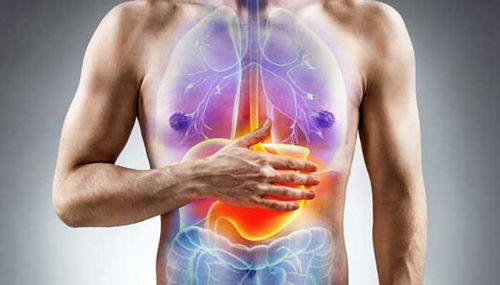Most lung cancer arises from lung cells, but it can also spread (metastasize) to the lungs from other body parts. Lung cancer is the most common cancer in men in Slovenia (80 cases per 100,000 inhabitants), but it is rarer in women (16 cases per 100,000 inhabitants). It is also among the leading causes of death from cancer.
LUNG CANCER: General | Symptoms | Causes | Types of lung cancer | Diagnosis | Treatment | Questions and Answers | Sources/references
Lung cancer is a disease in which malignant (cancerous) tumors form in lung tissues.
There are two main types of lung cancer: small cell lung cancer (SCLC) and non-small cell lung cancer (NSCLC). While small cell lung cancer usually spreads quickly, non-small cell lung cancer is more frequently diagnosed and accounts for the majority of cases.
Lung cancer is often associated with long-term cigarette smoking, but it can also occur in non-smononsmokers, although the risk is lower.
Image: A small proportion of lung cancer is caused by substances you encounter at work.
.jpg)
Other risk factors for developing lung cancer include exposure to toxic chemicals, air pollution, genetic predisposition, and radiation exposure.
Symptoms
Symptoms of lung cancer depend on its type, location, and method of spread. Usually, the main symptom is a persistent cough. People with chronic bronchitis who develop lung cancer often find that their cough has worsened. The discharge may be bloody. If the cancer grows into a vein, it can cause severe bleeding.
Cancer can cause wheezing because it narrows the airway in or around which it grows. Blockage of the bronchus can lead to the collapse of the part of the lung supplied by the affected bronchus; this is called atelectasis. Another consequence can be pneumonia with cough, fever, chest pain, and difficulty breathing. If the tumor grows into the chest wall, it can cause constant chest pain.
Symptoms that occur later include loss of gait, weight loss, and weakness. Lung cancer often causes fluid to build up around the lungs (pleural effusion), resulting in difficulty breathing. If the cancer spreads to the lungs, harsh breathing, low blood oxygen levels, and heart failure can occur.
Image: Usually, the main symptom is a stubborn cough.
.jpg)
Cancer sometimes grows in specific nerves in the neck. Thus, it causes drooping of the eyelid, pupil narrowing, sunken eyes, and reduced sweating on one side of the face; such a set of symptoms is called Homer's syndrome. A cancerous growth at the top of the lung can affect the nerves that supply the arm, causing the arm to become painful, numb, and weak. The nerves of the throat may also be damaged, which is why the patient becomes hoarse.
Cancer can grow directly into the esophagus, or it can grow next to it and press on it; the result is difficulty swallowing in both cases. Sometimes, an abnormal channel (fistula) forms between the esophagus and the bronchi, which causes severe coughing during swallowing because food and liquid enter the lungs through it.
Lung cancer can grow into the heart and cause heart rhythm disturbances, an enlarged heart, or a build-up of fluid between the leaflets of the pericardium, which surrounds the heart. Cancer can grow in or around the superior vena cava (one of the large veins in the chest).
Obstruction of this vein causes blood to stagnate in other upper-body veins. The veins on the chest wall expand. The face, neck, and upper chest wall—including the breasts—swell and take on a purplish tinge. The condition also causes shortness of breath, headache, visual disturbances, dizziness, and drowsiness. These symptoms usually worsen when the patient bends forward or lies down.
Lung cancer can spread through the blood to the liver, brain, adrenal glands, and bones. This sometimes happens early in the disease, especially in small-cell carcinoma. Symptoms - e.g., liver failure, confusion, seizures, and bone pain - can occur before any lung problems develop, making early diagnosis difficult.
In some cases, lung cancer causes effects far beyond the lungs, e.g., metabolic, nervous, and muscular disorders (paraneoplastic syndromes). Paraneoplastic syndromes are not related to the size or location of the lung cancer and do not necessarily mean that the cancer has spread outside the chest; substances secreted by the cancer cause them. These symptoms can be the first signs of cancer or the first indicator that cancer has returned after treatment.
One of the examples of paraneoplastic syndrome is Eaton-Lambert syndrome. It is characterized by extreme muscle weakness. Another example is muscle weakness and pain due to inflammation (polymyositis). They may be accompanied by skin inflammation (dermatomyositis).
Video content: Lung cancer surgery according to the classic open method.

Some lung cancers secrete hormones or hormone-like substances and thus cause an abnormally high concentration of hormones, test cell tumors can e.g. they secrete corticotropin (thus causing Cushing's syndrome) or achtidiuretic hormone (this causes water retention in the body and low sodium concentration in the blood). Excessive production of hormones can also be the cause of carcinoid syndrome - flushing, wheezing, diarrhea, and problems with heart valves.
Squamous cell carcinoma can secrete hormone-like substances, and this causes very high levels of calcium in the blood. Other hormonal syndromes associated with lung cancer include male breast enlargement (gynecomastia) and excess thyroid hormones (hyperthyroidism). Skin changes may also occur, including darkening of the skin under the armpit. Lung cancer sometimes even changes the shape of fingers and toes and causes changes at the ends of long bones. They can be seen on X-rays.
Causes
The leading cause of about 90 percent of lung cancer cases in men and about 70 percent in women is cigarette smoking. In the developed world, lung cancer has become more common in women as the number of women smokers has increased. The more cigarettes an individual smokes, the greater the risk of lung cancer.
A small proportion of lung cancer (about 10 to 15 percent in men and 5 percent in women) is caused by substances an individual encounters or inhales while working. Exposure to asbestos, radiation, arsenic, chromates, nickel, chloromethyl ethers, mustard gas, and coke oven emissions are associated with lung cancer, although usually only in people who also smoke.
The role of air pollution in developing lung cancer is still uncertain. Exposure to radon gas in the home may be significant in a small number of cases. Sometimes, lung cancer, especially adenocarcinoma and alveolar cell carcinoma, develops in people whose lungs are scarred by other lung diseases, such as tuberculosis or fibrosis.
Types of lung cancer
More than 90 percent of lung cancer cases arise in the bronchi (trachea, the most significant airways in the lungs); such cancer is called bronchogenic carcinoma. The types are squamous cell (epidermoid) carcinoma, small cell carcinoma (oat), large cell carcinoma, and adenocarcinoma. Alveolar cell carcinoma originates in the lung's air sacs (alveoli). Although it can be a single growth, it often develops in several parts of the lung simultaneously.
Image: Alveolar cell carcinoma originates from the lung air sacs.
.jpg)
Less common lung tumors are bronchial adenoma (which can be cancerous or non-cancerous), chondromatous hamartoma (non-cancerous), and sarcoma (cancerous). Lymphoma is a cancer of the lymphatic system. It can originate in or spread to the lungs. Many cancers start elsewhere in the body and spread to the lungs. Cancer from the breast, colon, prostate, kidney, thyroid, stomach, cervix, rectum, testicle, bone, and skin most often spreads to the lungs.
Diagnosis
The doctor investigates the possibility of lung cancer if the patient (especially if he is a smoker) has a persistent cough, if the cough gets worse, or if he has other lung-related symptoms. Sometimes, the first clue is a shadow seen on a chest x-ray in a person with no symptoms.
A chest X-ray detects most lung tumors but may miss small ones. However, such imaging only shows a shadow on the lung, which is not evidence of cancer. Microscopic examination of the tissue sample is usually required. Sometimes a sample of coughed up sputum provides enough material for such an examination (this is called sputum cytology), otherwise a tissue sample can be obtained by bronchoscopy.
Image: A microscopic examination of the tissue sample is usually required.

If the cancer is too deep in the lung to be reached with a bronchoscope, the doctor usually takes a sample by sticking a needle through the skin into the tumor and uses computed tomography (CT) as a guide. The procedure is called a needle biopsy. Sometimes, the sample can only be obtained through a thoracotomy.
Video content: Lung cancer - the most comprehensive explanation.

Computed tomography can show tiny shadows otherwise not visible on a chest X-ray. CT scans also show whether the lymph nodes are enlarged. Still, a biopsy (removal of a piece of tissue for microscopic examination) is often required to determine whether the enlargement is due to inflammation or cancer. Such scans of the abdomen or head can show whether the cancer has spread to the liver, adrenal glands, or brain. A bone scan shows whether it has spread into the bones. Doctors sometimes do a bone marrow biopsy because small cell carcinoma often spreads to the bone marrow.
Doctors classify cancer based on the size of the tumor, whether it has spread to nearby lymph nodes, and whether it has spread to distant organs. The different stages are called stages. The cancer stage helps to decide on the most appropriate treatment and allows the doctor to assess the patient's prognosis.
Treatment
Non-cancerous bronchial tumors are usually removed surgically because they can block the bronchi and because they can eventually become cancerous. Doctors often cannot be sure whether a tumor at the edge of the lung is cancerous until it is removed and examined under a microscope.
Non-small cell cancers that have not yet spread outside the lungs can sometimes be operated on. Although 10 to 35 percent of cancer can be surgically removed, removal does not always mean a cure. Of patients who have a single, slow-growing tumor and have it removed, 25 to 40 percent survive at least five years after diagnosis.
Survivors must have regular check-ups, as lung cancer recurs in 6 to 12 percent of patients who have undergone surgery. The proportion is much higher among those who continue to smoke even after the operation.
Before surgery, the doctor performs lung function tests on the patient to determine whether the remaining lungs can provide adequate function. If the test results are poor, surgery may not be possible. How much lung needs to be removed is decided by the surgeon during the operation, and the extent of the removed part can range from a small piece to an entire lung wing.
Sometimes, cancer that starts elsewhere and spreads to the lungs is removed after the tumor at the site of origin has already been removed. This procedure is rarely recommended, and only about 10 percent of patients who undergo it survive five years or more.
If the cancer has spread outside the lungs, if it is too close to the trachea, or if the patient has other serious illnesses (e.g., severe heart or lung disease), surgery is not an option. Patients who cannot undergo surgery due to other serious diseases can be treated with radiation. In such cases, the purpose of radiation is not to cure but to slow down the cancerous growth.
Image: In approximately 25 percent of patients, chemotherapy significantly prolongs survival.
.jpg)
Radiation is also beneficial for managing bone pain, superior vena cava syndrome, and spinal cord compression. However, radiation can cause inflammation in the lungs (radiation pneumonitis). This causes coughing, shortness of breath, and fever. These symptoms may be relieved by corticosteroids, e.g., prednisone. Except for small cell cancer, no chemotherapy scheme is particularly effective for other types of lung cancer.
Since small-cell lung carcinoma has almost always spread to distant parts of the body by the time the diagnosis is made, surgical treatment is out of the question. Instead, it is treated with chemotherapy, sometimes combined with radiation. In about 25 percent of patients, chemotherapy significantly prolongs survival. Patients with small cell lung carcinoma who respond well to chemotherapy may benefit from radiation to the head to treat cancer that has spread to the brain.
Many patients with lung cancer experience a significant decline in lung function, whether they are treated or not. Oxygen therapy and medicines that widen the airways (bronchodilators) can ease breathing problems. Many patients with advanced lung cancer have such pain and difficulty breathing that in the weeks or months before they die, they need large doses of narcotic drugs. Fortunately, narcotic drugs can be beneficial if used in large enough doses.
Questions and answers
How common is lung cancer?
In general, a man's lifetime chance of developing lung cancer is about 1 in 16; for women, the risk is about 1 in 17. These numbers include both smokers and nonsmoknonsmokersisk is much higher in people who smoke but lower in non-smononsmokers. Is smoking always associated with lung cancer?
Cigarette smoking is associated with approximately 80% to 90% of lung cancer deaths. The use of other tobacco products, such as cigars or pipes, also increases the risk of lung cancer. Tobacco smoke is a toxic mixture of more than 7,000 chemicals[2].
What are the symptoms of lung cancer?
Symptoms of lung cancer depend on its type, location, and method of spread. Usually, the main symptom is a persistent cough. People with chronic bronchitis who develop lung cancer often find that their cough has worsened. Cancer can cause wheezing, pneumonia with cough, fever, chest pain, and difficulty breathing. Symptoms that appear later include loss of gait, weight loss, and weakness.
Can lung cancer also affect children?
The incidence of primary lung cancer in children is rare, estimated at 1 in 2 million or 0.2% of all childhood malignancies[3].
What can lung cancer cause?
Risk factors for lung cancer include:
- smoking
- exposure to passive smoking
- previous radiotherapy
- exposure to radon gas
- exposure to asbestos and other carcinogenic substances
- family history of lung cancer[4]
Sources and references
Extensive health manual for home use, Youth Book Publishing House
- Key Statistics for Lung Cancer - https://www.cancer.org
- What Are the Risk Factors for Lung Cancer? - https://www.cdc.gov
- Pediatric Lung Cancer - https://www.sciencedirect.com
- Lung cancer - https://www.mayoclinic.org













